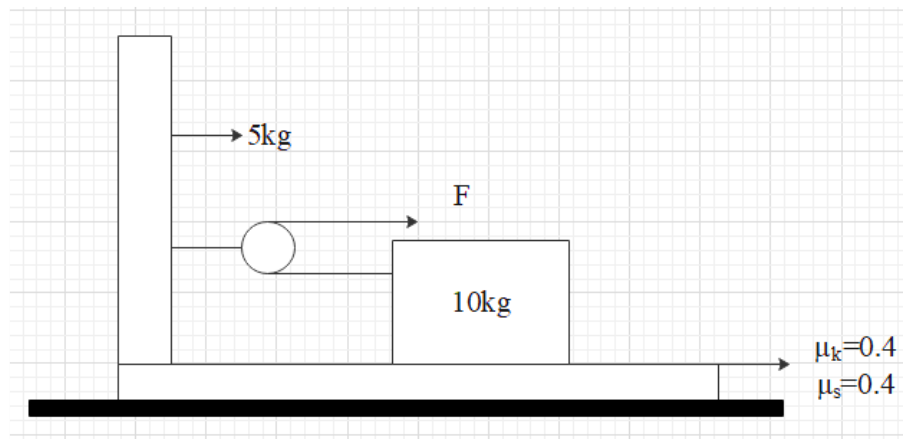
Calculate the maximum force $F$ that can be applied when the $10Kg$ block is not to slide on the bracket?

$\begin{align}
& A.32N \\
& B.24N \\
& C.18N \\
& D.48N \\
\end{align}$
Answer
217.5k+ views
Hint: When the block does not slide on the bracket, we can check the block and bracket as one body, which has been experienced by the pulling force. The free-body diagram of the block shows that the tension on the rope must be identical everywhere along the rope. Find out the vertically and horizontally experienced forces. The acceleration of the body can be found by taking the ratio of the mass of the block to the whole mass of the system.
This all will help you in answering this question.
Complete step-by-step solution
When the block does not slide on the bracket, we can check the block and bracket as one body which has been experienced on by the pulling force,$F$
In order to get the force we can write that,
$F=\left( {{m}_{5}}+{{m}_{10}} \right)a$
The free body diagram of the block shows that the tension on the rope must be the identical everywhere along the rope,
$\therefore T=F$
Vertically the force can be shown to be as,
$\begin{align}
& {{F}_{N}}-mg=0 \\
& \Rightarrow {{F}_{N}}={{m}_{10}}g \\
\end{align}$
In the horizontal direction, the balancing of the force has been taking place as the following,
${{F}_{f}}-T={{m}_{10}}a$
From this we can say that,
${{F}_{f}}=\mu {{F}_{N}}$
The acceleration of the body can be found by taking the ratio of the mass of the block to the whole mass of the system.
$a=\dfrac{{{m}_{10}}}{{{m}_{5}}+{{m}_{10}}}$
Therefore the force can be written as,
$F={{m}_{10}}a=F+\dfrac{{{m}_{10}}}{{{m}_{5}}+{{m}_{10}}}F$
That is,
$\begin{align}
& {{\mu }_{5}}{{m}_{10}}g=F+\dfrac{{{m}_{10}}}{{{m}_{5}}+{{m}_{10}}}F \\
& \Rightarrow {{\mu }_{5}}{{m}_{10}}g=F\left( 1+\dfrac{{{m}_{10}}}{{{m}_{5}}+{{m}_{10}}} \right) \\
\end{align}$
Rearranging this equation in terms of the force can be written as,
$\Rightarrow F={{\mu }_{5}}{{m}_{10}}g\dfrac{\left( {{m}_{5}}+{{m}_{10}} \right)}{\left( {{m}_{5}}+2{{m}_{10}} \right)}$
Substituting the values in the equation can be shown as,
$\Rightarrow F=0.4\times 10\times 9.8\left( \dfrac{15kg}{25kg} \right)$
Hence by simplifying this equation we can write that,
$F=23.5N$
The force has been calculated. The correct answer has been approximately given as option B.
Note: The acceleration of an object can be defined as the rate of variation of the velocity of the body with respect to the time taken. The velocity can be defined as the rate of variation of the displacement of the body with respect to the time taken. Both these quantities are found to be vectors.
This all will help you in answering this question.
Complete step-by-step solution
When the block does not slide on the bracket, we can check the block and bracket as one body which has been experienced on by the pulling force,$F$
In order to get the force we can write that,
$F=\left( {{m}_{5}}+{{m}_{10}} \right)a$
The free body diagram of the block shows that the tension on the rope must be the identical everywhere along the rope,
$\therefore T=F$
Vertically the force can be shown to be as,
$\begin{align}
& {{F}_{N}}-mg=0 \\
& \Rightarrow {{F}_{N}}={{m}_{10}}g \\
\end{align}$
In the horizontal direction, the balancing of the force has been taking place as the following,
${{F}_{f}}-T={{m}_{10}}a$
From this we can say that,
${{F}_{f}}=\mu {{F}_{N}}$
The acceleration of the body can be found by taking the ratio of the mass of the block to the whole mass of the system.
$a=\dfrac{{{m}_{10}}}{{{m}_{5}}+{{m}_{10}}}$
Therefore the force can be written as,
$F={{m}_{10}}a=F+\dfrac{{{m}_{10}}}{{{m}_{5}}+{{m}_{10}}}F$
That is,
$\begin{align}
& {{\mu }_{5}}{{m}_{10}}g=F+\dfrac{{{m}_{10}}}{{{m}_{5}}+{{m}_{10}}}F \\
& \Rightarrow {{\mu }_{5}}{{m}_{10}}g=F\left( 1+\dfrac{{{m}_{10}}}{{{m}_{5}}+{{m}_{10}}} \right) \\
\end{align}$
Rearranging this equation in terms of the force can be written as,
$\Rightarrow F={{\mu }_{5}}{{m}_{10}}g\dfrac{\left( {{m}_{5}}+{{m}_{10}} \right)}{\left( {{m}_{5}}+2{{m}_{10}} \right)}$
Substituting the values in the equation can be shown as,
$\Rightarrow F=0.4\times 10\times 9.8\left( \dfrac{15kg}{25kg} \right)$
Hence by simplifying this equation we can write that,
$F=23.5N$
The force has been calculated. The correct answer has been approximately given as option B.
Note: The acceleration of an object can be defined as the rate of variation of the velocity of the body with respect to the time taken. The velocity can be defined as the rate of variation of the displacement of the body with respect to the time taken. Both these quantities are found to be vectors.
Recently Updated Pages
Addition of Three Vectors: Methods & Examples

Addition of Vectors: Simple Guide for Students

Algebra Made Easy: Step-by-Step Guide for Students

Relations and Functions: Complete Guide for Students

Analytical Method of Vector Addition Explained Simply

Arithmetic, Geometric & Harmonic Progressions Explained

Trending doubts
JEE Main 2026: Application Form Open, Exam Dates, Syllabus, Eligibility & Question Papers

Derivation of Equation of Trajectory Explained for Students

Hybridisation in Chemistry – Concept, Types & Applications

Understanding the Angle of Deviation in a Prism

Understanding Collisions: Types and Examples for Students

How to Convert a Galvanometer into an Ammeter or Voltmeter

Other Pages
JEE Advanced Marks vs Ranks 2025: Understanding Category-wise Qualifying Marks and Previous Year Cut-offs

Units And Measurements Class 11 Physics Chapter 1 CBSE Notes - 2025-26

NCERT Solutions For Class 11 Physics Chapter 8 Mechanical Properties Of Solids

Motion in a Straight Line Class 11 Physics Chapter 2 CBSE Notes - 2025-26

NCERT Solutions for Class 11 Physics Chapter 7 Gravitation 2025-26

Understanding Atomic Structure for Beginners




